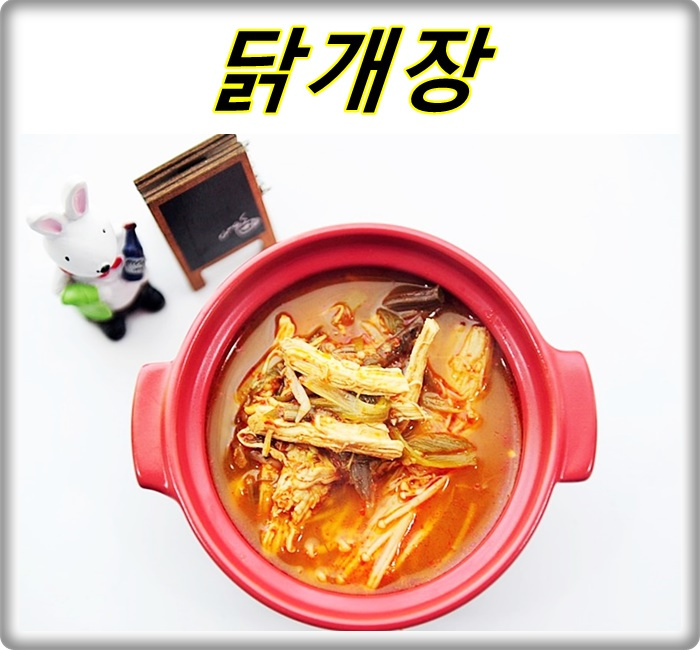Spicy and Hearty Chicken Stew (Dakgaejang) Recipe
Warm up from the inside out! A delicious and easy Dakgaejang recipe

I had planned to start cooking this early this morning, but after cleaning and tidying up, it’s already 1 PM. I thought I’d finish everything in the morning, but I spent all my time taking photos and just realized I missed photographing one of the steps. It feels too bothersome to set everything up again… Plus, I’m getting a headache that hasn’t bothered me for a while, so today, I just feel like doing nothing. I have an afternoon schedule tomorrow, so I’ll have to rush and take photos in the morning. The weather is getting colder, so I felt like having a warm soup, and that’s why I made Dakgaejang. My mom used to make Yukgaejang or Dakgaejang often, but I usually chose to buy it. Today, I decided to make it myself after mustering up some courage and buying a few ingredients. It was a bit of a undertaking, but the homemade taste is truly special.
Ingredients- Chicken breast 1 pack (approx. 300g)
- 1/2 Onion
- 2 Green onions
- 1 piece Ginger
- 5 cloves Garlic
- 1 handful Scallion roots
- 2 Bay leaves
- 1 handful Gosari (bracken fern, pre-cooked)
- 1 handful Bean sprouts
- 1/2 pack Enoki mushrooms
- 3 Tbsp Gochugaru (Korean chili flakes)
- 3 Tbsp Cooking oil
- Salt to taste
- Black pepper to taste
- 1 Tbsp Cooking wine (Mirin or similar)
- 1 Tbsp Minced garlic
- 2 Tbsp Soy sauce for soup (Guk-ganjang) or to taste
Cooking Instructions
Step 1
First, rinse the chicken breast thoroughly. In a pot, add the chicken breast along with half an onion, one green onion, scallion roots, ginger, garlic cloves, and bay leaves. Boil until the chicken breast is fully cooked. Adding aromatic vegetables like these helps eliminate any gamey smell from the chicken and adds depth to the broth.

Step 2
Once the chicken breast is cooked, remove it from the pot and let it cool slightly. Then, shred it along the grain into bite-sized pieces. Season the shredded chicken with a pinch of salt, some coarse black pepper, and 1 tablespoon of cooking wine. Mix well and let it marinate for about 10 minutes to allow the flavors to penetrate. Don’t discard the chicken broth; strain it and set it aside to use as stock later.

Step 3
Now, let’s prepare the green onions, a key ingredient for Dakgaejang. Green onions are known to be rich in allicin, which is beneficial for boosting immunity and preventing colds. That’s why I’ve used a generous amount of green onions for this recipe! Cut the green onions into about 4-5 cm lengths or thinly slice them into shreds. Heat 3 tablespoons of cooking oil in a pan over low heat and slowly sauté the sliced green onions until fragrant and slightly softened, creating ‘pa-gi-reum’ (scallion oil). This technique, popularized by Korean cooking shows, adds a wonderful depth of flavor to dishes.

Step 4
Once the green onions turn lightly golden, add 3 tablespoons of gochugaru (Korean chili flakes). Stir constantly over low heat to prevent burning. Sautéing the chili flakes in oil reduces any harshness and enhances the color and savory flavor. The green onions I bought were quite thick and fresh, so I used about two stalks. They were on sale for 980 won per bunch, so I regret not buying more!

Step 5
Add the marinated shredded chicken and the pre-cooked gosari (bracken fern) to the pan with the sautéed green onions and chili oil. Mix everything together well, ensuring the ingredients are evenly combined and coated. This sautéing step helps to meld the flavors and deepen the overall taste of the dish.

Step 6
Pour the reserved chicken broth into the pan with the sautéed ingredients. Even though it’s just chicken broth, it will provide a much richer and deeper flavor compared to plain water. Bring the mixture to a boil over high heat.

Step 7
Once the broth starts boiling, add 1 tablespoon of minced garlic. Adjust the seasoning with soy sauce for soup (guk-ganjang). I initially didn’t plan to add more soy sauce, but it tasted a bit bland, so I added some. A dish is only truly delicious when it’s seasoned well, so please adjust the seasoning to your preference using soy sauce or salt.

Step 8
Finally, add a handful of washed bean sprouts and the enoki mushrooms. Let it simmer briefly. I was initially only going to add bean sprouts, but I found some enoki mushrooms in the fridge and decided to throw them in too. Adding enoki mushrooms seems to have added another layer of savory flavor to the soup. Making Dakgaejang might involve several steps for preparation, but it’s not overly complicated, is it?

Step 9
When you’re craving a warm and spicy soup, why not try making a bowl of homemade Dakgaejang? Add chicken, and it’s Dakgaejang; add beef, and it’s Yukgaejang! Either way, you’ll enjoy a hearty and delicious meal. While it does require a bit of effort, the resulting homemade taste is incredibly rewarding. Enjoy your meal and have a warm day!




